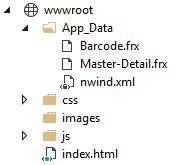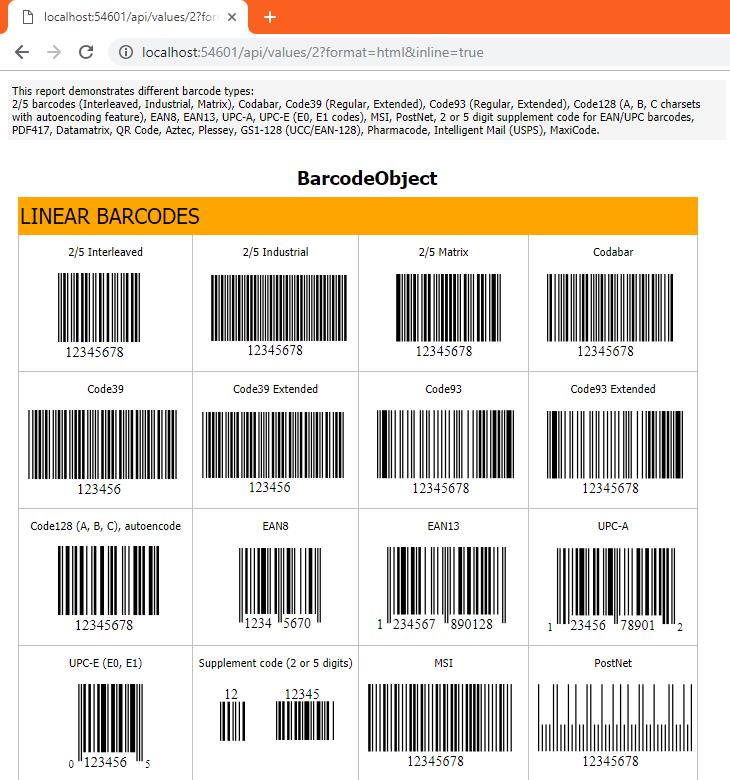如何在Web API应用程序中使用FastReport
Posted 小欻欻1号
tags:
篇首语:本文由小常识网(cha138.com)小编为大家整理,主要介绍了如何在Web API应用程序中使用FastReport相关的知识,希望对你有一定的参考价值。
在本文中,我们将创建一个用于从服务器接收FastReport报表的API。首先,让我们定义API是什么。从字面上看,这个缩写代表了应用程序的软件界面。这意味着应用程序具有提供对其功能的访问的接口。在Web应用程序的上下文中,API是一种Web服务,具有一组与后端(应用程序或数据库)交互的方法。换句话说,系统对我们来说是一个黑盒子,只有Web方法允许我们使用它。
因此,我们确定Web Api是一个带有一组Web方法的Web服务。这些可以是HTTP协议支持的四种基本CRUD功能。它们由请求实现:GET - 读取,POST - 创建,PUT - 更改,DELETE - 删除。
我们将在本文中创建此Web应用程序。而专为.Net Core框架设计的FastReport.Core将为我们生成报表。 创建一个ASP .Net Core Web应用程序。在向导的第二步中创建一个新项目,您可以选择Web应用程序的类型 - Web API:

首先,我们需要使用Nuget包管理器连接库。

要安装FastReport.Core和FastReport.Web包,您需要选择本地存储库。但是,它必须配置。在存储选择下拉列表旁边有一个齿轮图标。单击它并查看设置窗口:

选择“Local package source”并更改源的路径。然后,单击“Update”按钮。现在,在包管理器中,我们可以安装FastReport.Core和FastReport.Web。 在我们的演示中,我们将了解如何从服务器下载报表,如何在浏览器中查看报表以及如何将参数传递给报表。因此,我们将使用的主要实体是报表。让我们将Reports类添加到数据模型中,该模型将包含两个字段:Id - 报表标识符,ReportName - 报表名称。
模型Reports.cs
public class Reports
{
// Report ID
public int Id { get; set; }
// Report File Name
public string ReportName { get; set; }
}
在Controllers包中,默认情况下有一个ValuesController.cs类。我们用它。 在使用部分,我们需要库:
using System; using System.Collections.Generic; using System.Linq; using Microsoft.AspNetCore.Mvc; using Microsoft.AspNetCore.Hosting; using WebApiCore.Models; using System.IO; using System.Data; using FastReport.Utils; using FastReport; using FastReport.Export.html; using FastReport.Export.Pdf;
用于接收报表的URL可能包含其他参数:报表文件的格式,内联显示的符号,传递给报表的参数。将包含必填字段的类添加到控制器:
public class ReportQuery
{
// Format of resulting report: png, pdf, html
public string Format { get; set; }
// Enable Inline preview in browser (generates "inline" or "attachment")
public bool Inline { get; set; }
// Value of "Parameter" variable in report
public string Parameter { get; set; }
}
我们需要两个我们将演示的报表模板和一个数据库。我们使用交付的报表:Master-Detail.frx和Barcodes.frx。第一个报表的nwind.xml数据库也来自FR的交付。我们将这三个文件放在App_Data文件夹中,该文件夹将在wwwroot目录中创建。

控制器类可以具有执行路由角色的Route属性。这意味着此类仅接受来自指定路径的请求。我将使用注释来解释代码,以及方法之间的文本插入。
[Route("api/[controller]")]
public class ValuesController : Controller
{
private readonly IHostingEnvironment _hostingEnvironment; // Use the web hosting environment interface to get the root path
public ValuesController(IHostingEnvironment hostingEnvironment)
{
_hostingEnvironment = hostingEnvironment;
}
// Create a collection of data of type Reports. Add two reports.
Reports[] reportItems = new Reports[]
{
new Reports { Id = 1, ReportName = "Master-Detail.frx" },
new Reports { Id = 2, ReportName = "Barcode.frx" }
};
在控制器中获取数据的默认方法是Get。通常它有一个重载版本,就像我们的情况一样。动作方法通常具有关联属性。该属性可以具有参数。
[HttpGet]
public IEnumerable<Reports> Get()
{
return reportItems; // Returns a list of reports.
}
// Attribute has required id parameter
[HttpGet("{id}")]
public IActionResult Get(int id, [FromQuery] ReportQuery query)
{
string mime = "application/" + query.Format; // MIME header with default value
// Find report
Reports reportItem = reportItems.FirstOrDefault((p) => p.Id == id); // we get the value of the collection by id
if (reportItem != null)
{
string webRootPath = _hostingEnvironment.WebRootPath; // determine the path to the wwwroot folder
string reportPath = (webRootPath + "/App_Data/" + reportItem.ReportName); // determine the path to the report
string dataPath = (webRootPath + "/App_Data/nwind.xml");// determine the path to the database
using (MemoryStream stream = new MemoryStream()) // Create a stream for the report
{
try
{
using (DataSet dataSet = new DataSet())
{
// Fill the source by data
dataSet.ReadXml(dataPath);
// Turn on web mode FastReport
Config.WebMode = true;
using (Report report = new Report())
{
report.Load(reportPath); // Download the report
report.RegisterData(dataSet, "NorthWind"); // Register data in the report
if (query.Parameter != null)
{
report.SetParameterValue("Parameter", query.Parameter); // Set the value of the report parameter if the parameter value is passed to the URL
}
report.Prepare();//Prepare the report
// If pdf format is selected
if (query.Format == "pdf")
{
// Export report to PDF
PDFExport pdf = new PDFExport();
// Use the stream to store the report, so as not to create unnecessary files
report.Export(pdf, stream);
}
// If html report format is selected
else if (query.Format == "html")
{
// Export Report to HTML
HTMLExport html = new HTMLExport();
html.SinglePage = true; // Single page report
html.Navigator = false; // Top navigation bar
html.EmbedPictures = true; // Embeds images into a document
report.Export(html, stream);
mime = "text/" + query.Format; // Override mime for html
}
}
}
// Get the name of the resulting report file with the necessary extension var file = String.Concat(Path.GetFileNameWithoutExtension(reportPath), ".", query.Format);
// If the inline parameter is true, then open the report in the browser
if (query.Inline)
return File(stream.ToArray(), mime);
else
// Otherwise download the report file
return File(stream.ToArray(), mime, file); // attachment
}
// Handle exceptions
catch
{
return new NoContentResult();
}
finally
{
stream.Dispose();
}
}
}
else
return NotFound();
}
现在我们需要一个网页来显示报表。当然,您可以不使用它并在地址栏中输入URL。但是,使用现成的报表超链接将更加清晰。 让我们创建一个简单的html索引文档。将它放在wwwroot文件夹的根目录中。这是它的内容:
<!DOCTYPE html> <html> <head> <title>FastReport.Core Web Api</title> <meta charset="utf-8" /> </head> <body> <h1>FastReport.Core Web Api</h1> <hr /> <a href="/api/values/">List Of All Reports</a><br /> <a href="/api/values/1?format=pdf">Get First Report in PDF</a><br /> <a href="/api/values/1?format=html">Get First Report in HTML</a><br /> <a href="/api/values/1?format=pdf&inline=true">Get First Report in PDF inline</a><br /> <a href="/api/values/2?format=html&inline=true">Get Second Report in HTML inline</a><br /> <a href="/api/values/1?format=pdf&inline=true¶meter=REPORT">Get First Report in PDF inline with Parameter=REPORT</a><br /> <a href="/api/values/1?format=html&inline=true¶meter=REPORT">Get First Report in HTML inline with Parameter=REPORT</a><br /> </body> </html> </html>
我们添加了7个超链接。第一个允许您显示可用报表的列表。第二个允许您下载PDF格式的索引为1的报表。第三个超链接允许您下载HTML格式的索引为1的报表。第四个 - 允许您在浏览器中以PDF格式打开索引为1的报表。第五个 - 允许您在浏览器中以HTML格式索引2打开报表。第六个 - 允许您在浏览器中以PDF格式打开索引为1的报表,并将参数值传送给它。第七个 - 允许您在浏览器中打开HTML格式的索引为1的报表,并将参数值传送给它。
当然,要在报表中显示参数的值,您需要将其添加到报表和报表页面。 但是,将index.html添加到根目录是不够的。为了在默认情况下打开此页面,您需要在启动设置中调整某些内容。打开Properties文件夹,即launchSettings.json文件。并删除两行:“launchUrl”:“api / values”。
要启用对静态页面和FastReport库的支持,请在Startup.cs中的Configure方法中添加几行:
app.UseFastReport(); app.UseDefaultFiles(); app.UseStaticFiles();
启动应用程序:

七个超链接的列表。让我们点击第一个:

报表列表以json格式显示。在.Net Core中,json完全取代了xml。事实是如此简洁和易懂。 单击第二个链接。浏览器以pdf格式下载报表:

单击第五个链接。浏览器将报表打开为html页面。

单击最后一个链接。报表也会在浏览器中打开,但请注意其标题。标题显示传递的参数的值 - REPORT。

因此,我们学习了如何使用FastReport.Core创建.Net Core Web API应用程序。
以上是关于如何在Web API应用程序中使用FastReport的主要内容,如果未能解决你的问题,请参考以下文章